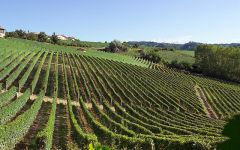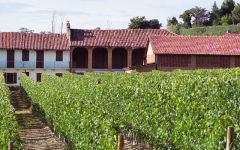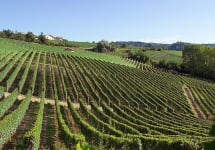Ascheri Barolo Ascheri 2016
-
Robert
Parker -
Wine
Enthusiast -
Wine
Spectator



Product Details
Your Rating
Somm Note
Winemaker Notes
Intense garnet red color. Rich and composite bouquet of ripe fruit, candied fruit, tobacco and sweet spices. Balanced, with an excellent structure and fine tannins perfectly integrated. Elegant and powerful wine at the same time.
Pairs well with roasted red meats, on the spit or grilled meats and ripe cheeses.
Professional Ratings
-
Robert Parker's Wine Advocate
The Ascheri 2016 Barolo Ascheri is a beautiful wine that reveals a broad range of classic Nebbiolo aromas. The wine's bouquet is stirring and deep with cleverly contained intensity. As I mentioned before, the Ascheri winemaking process sees a short 16-day fermentation, at 30 degrees Celsius in the case of this wine. As a result, the aromas are clear, strong and direct. You could apply any number of descriptors to describe the bouquet: dried cherry fruit, rose, pressed violets, crushed stone, red clay and autumnal leaf. The wine is well supported at the back by firm tannins that come thanks to this classic, cellar-worthy vintage. Rating : 94+
-
Wine Enthusiast
New leather, camphor, wild berry and fragrant blueflower aromas mingle together on this structured red. It’s full bodied and dense, delivering succulent morello cherry, crushed raspberry licorice and tobacco framed in firm, fine-grained tannins. You’ll also detect the warmth of evident alcohol, but thanks to the concentrated fruit, it doesn’t dominate
-
Wine Spectator
Fierce tannins and a dense structure watch over the macerated cherry, strawberry, eucalyptus, leather and tobacco flavors in this complex red. The initial suppleness stands in contrast to the firm grip on the finish. Fine length. Best from 2023 through 2043.
Other Vintages
2019-
Robert
Parker



The Giacomo Ascheri Cellars originated in La Morra: in the early 19th century, the first vines were planted in that area, where a place called “Ascheri” still exists, and the first wines were produced.
At that time in the Langhe, vine-growing and wine-making were still primitive and rudimental: wines were mostly sold in demijohns and they travelled for several days before reaching the selling points. However, a reliable account dating back to that period and concerning the “Ascheri” vine cultivation method (then considered modern for its technical innovations) clearly shows how, since its very beginning, the Ascheri Winery stood out for its commitment and innovative methods.
In that period, thanks to its geographical position, Bra had become the most important town for the distribution of Barolo, the best known wine of the area. Bra was, in fact, conveniently located and it had good connections with Turin, the most important wine market in the region due to the presence of the Royal House of Savoy. The Royal Family itself owned important estates in the surroundings of Bra, such as the Pollenzo Estate and the S.Vittoria d’Alba old Winery.
For these reasons, in 1880 their winery was moved from La Morra to Bra, where it is still situated nowadays. At present the cellars are the only ones left which can boast such an ancient and beautiful heritage. The years from the early 20th century to their days have been characterized by a steady effort to increase the value of their products.
With a view to expanding the estates by acquiring the most valuable production areas, they have subsequently added to the original La Morra Vineyards (mainly producing grapes for Barolo, Barbera d’Alba and Dolcetto d’Alba) the estates of Serralunga d’Alba, Verduno and Bra.

Responsible for some of the most elegant and age-worthy wines in the world, Nebbiolo, named for the ubiquitous autumnal fog (called nebbia in Italian), is the star variety of northern Italy’s Piedmont region. Grown throughout the area, as well as in the neighboring Valle d’Aosta and Valtellina, it reaches its highest potential in the Piedmontese villages of Barolo, Barbaresco and Roero. Outside of Italy, growers are still very much in the experimentation stage but some success has been achieved in parts of California. Somm Secret—If you’re new to Nebbiolo, start with a charming, wallet-friendly, early-drinking Langhe Nebbiolo or Nebbiolo d'Alba.

The center of the production of the world’s most exclusive and age-worthy red wines made from Nebbiolo, the Barolo wine region includes five core townships: La Morra, Monforte d’Alba, Serralunga d’Alba, Castiglione Falletto and the Barolo village itself, as well as a few outlying villages. The landscape of Barolo, characterized by prominent and castle-topped hills, is full of history and romance centered on the Nebbiolo grape. Its wines, with the signature “tar and roses” aromas, have a deceptively light garnet color but full presence on the palate and plenty of tannins and acidity. In a well-made Barolo wine, one can expect to find complexity and good evolution with notes of, for example, strawberry, cherry, plum, leather, truffle, anise, fresh and dried herbs, tobacco and violets.
There are two predominant soil types here, which distinguish Barolo from the lesser surrounding areas. Compact and fertile Tortonian sandy marls define the vineyards farthest west and at higher elevations. Typically the Barolo wines coming from this side, from La Morra and Barolo, can be approachable relatively early on in their evolution and represent the “feminine” side of Barolo, often closer in style to Barbaresco with elegant perfume and fresh fruit.
On the eastern side of the Barolo wine region, Helvetian soils of compressed sandstone and chalks are less fertile, producing wines with intense body, power and structured tannins. This more “masculine” style comes from Monforte d’Alba and Serralunga d’Alba. The township of Castiglione Falletto covers a spine with both soil types.
The best Barolo wines need 10-15 years before they are ready to drink, and can further age for several decades.
